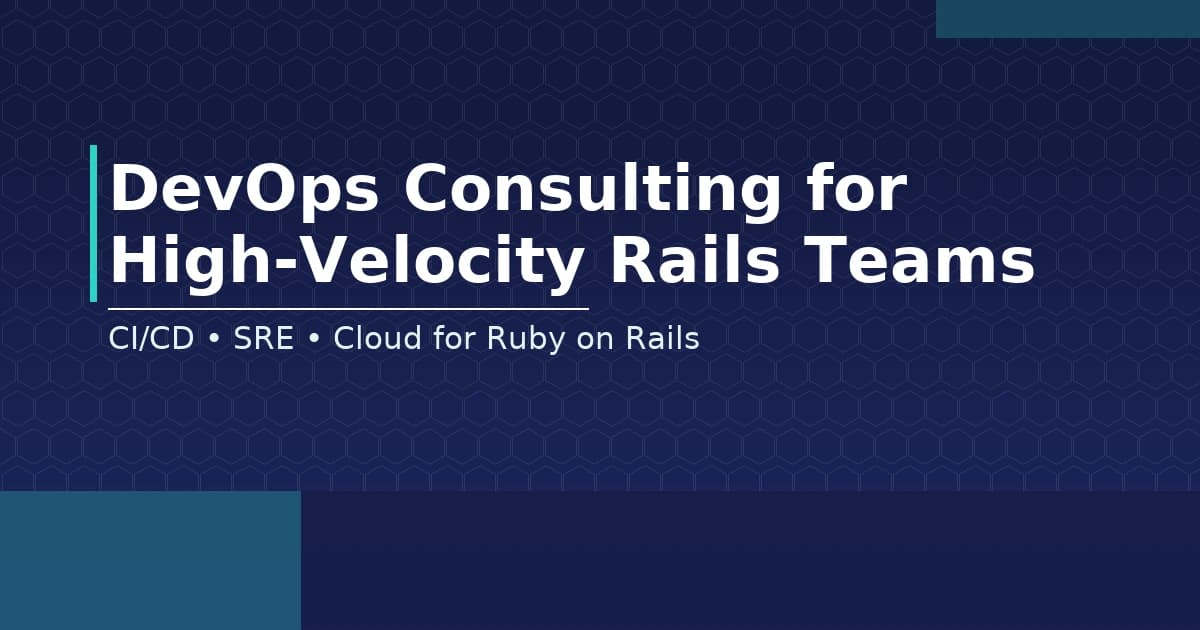Introduction
Shipping fast is easy. Shipping fast reliably is where teams stall. This post shows how we set up DevOps for Rails teams—focused on outcomes: faster CI, safer deploys, fewer incidents, and clear observability.
Outcomes We Optimise For
- CI from ~25 → <10 minutes with proper caching and parallelism
- Safe deploys (blue/green or canary) + reliable rollbacks
- p95 latency & error rate watched per endpoint and background job
- Core Web Vitals gains by moving heavy work off the request cycle
- Predictable costs via infra tagging and budgets
The Five Pillars We Implement
1) CI/CD That Doesn’t Slow You Down
- Build once; promote the same artifact between envs
- Split tests by timing data; cache bundler, npm, and Docker layers
- Ephemeral preview envs for risky PRs
# .github/workflows/ci.yml (excerpt)
name: CI
on: [push, pull_request]
jobs:
test:
runs-on: ubuntu-latest
strategy: { fail-fast: false, matrix: { ruby: [3.3] } }
steps:
- uses: actions/checkout@v4
- uses: ruby/setup-ruby@v1
with: { ruby-version: 3.3, bundler-cache: true }
- name: DB
uses: harmon758/postgresql-action@v1
with: { postgresql version: '15' }
- run: bin/rails db:prepare
- run: bundle exec rspec --format progress
2) Infrastructure as Code (IaC)
- Terraform modules for VPC, RDS, Redis, ECS/EKS, and GitHub OIDC
- Parameterized staging/prod; drift checks in CI
# terraform/environments/prod/main.tf (excerpt)
module "app_rds" {
source = "../modules/rds"
name = "asistensia-prod"
engine = "postgres"
size = "db.t4g.large"
backup_retention = 7
tags = { env = "prod", cost_center = "app" }
}
3) Observability Developers Actually Use
- Traces + logs + metrics (OpenTelemetry where possible)
- Golden signals per service; SLIs per user-critical flows
- Error budgets drive release decisions
4) Reliability & On-Call
- SLOs per surface (e.g., 99.9% API, 99.95% checkout)
- Playbooks & runbooks; incident templates and postmortems
- Synthetic checks for critical paths
5) Security & Compliance Basics
- Least-privilege IAM; secrets via SSM/Secrets Manager
- Dependency & container scans in CI
- Backups, PITR, and disaster recovery drills
Rails-Specific Wins
- Background jobs (Sidekiq) for heavy work; idempotent with retries/backoff
- Cache keys (not time-based expiry) and Redis memory policy sanity checks
- Database: composite/partial indexes, N+1 killers, archiving/partitioning
- Frontend vitals: self-host fonts (
display: swap),next/image, lazy-load non-hero media
Engagement Models
- Upgrade & hardening sprint (2–4 weeks)
- Team extension (pairing, PR reviews, pipelines, observability)
- Maintenance (SLAs, security updates, cost reviews)
Checklist to Get Moving
- CI under 10 min with caching/parallelism
- One-click rollback, canary enabled
- Traces/logs/metrics with alert thresholds
- SLOs & error budgets agreed with product
- IaC for all cloud resources, no “pets” infra
Conclusion
DevOps excellence isn’t about more tools—it’s about fewer surprises, faster feedback, and reliable delivery. If you’re ready to shorten CI times, harden releases, and see clear observability, we can help.
Written by Ahmad
Ahmad Hassan, Senior Ruby on Rails expert with 10+ years of experience. He builds web and mobile applications using React, Next.js, and TypeScript, and contributes to backend development using Python and Ruby on Rails.
